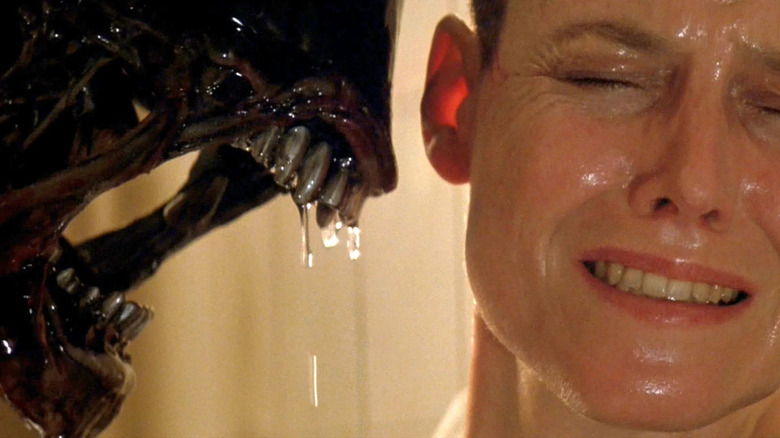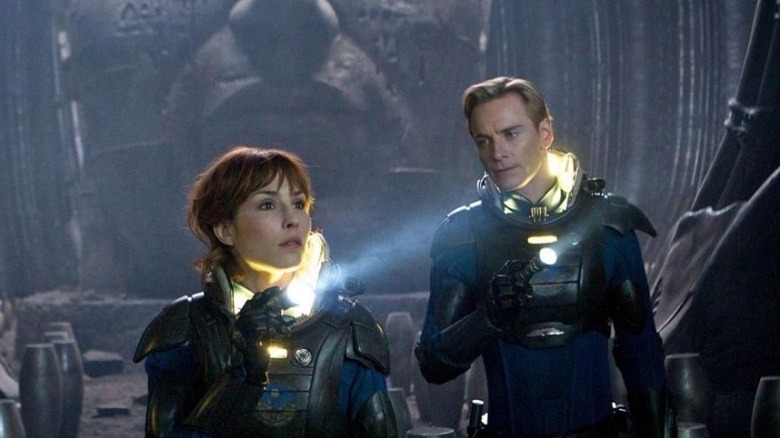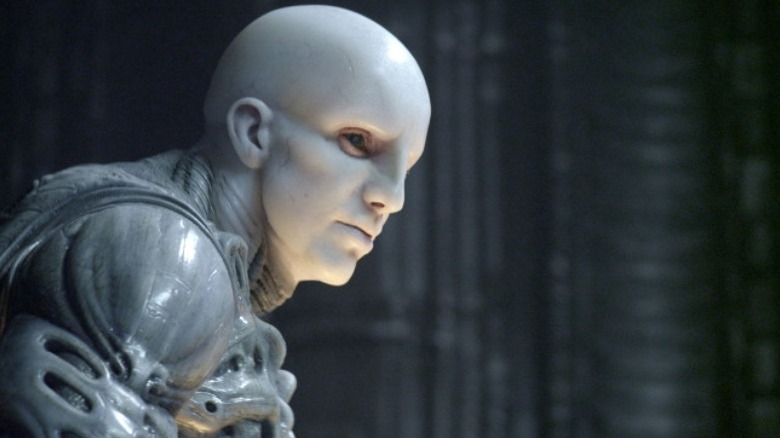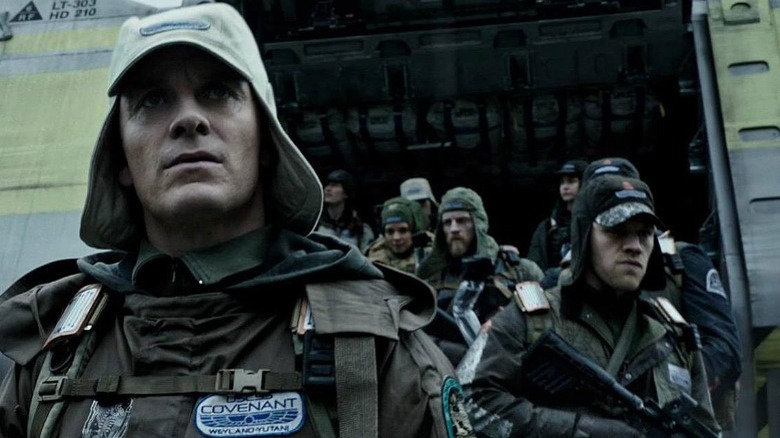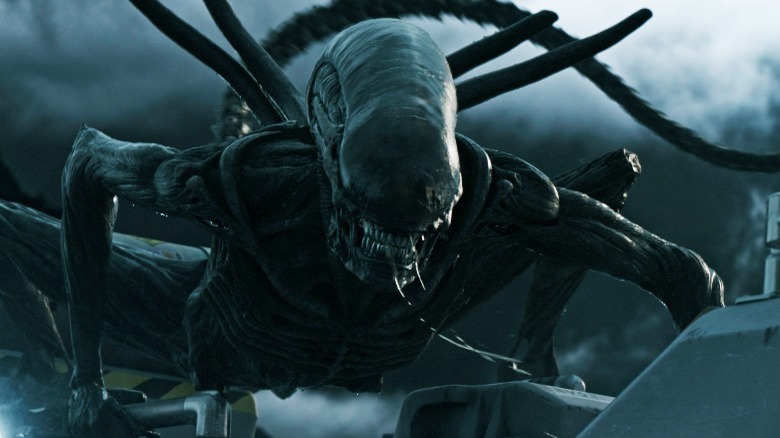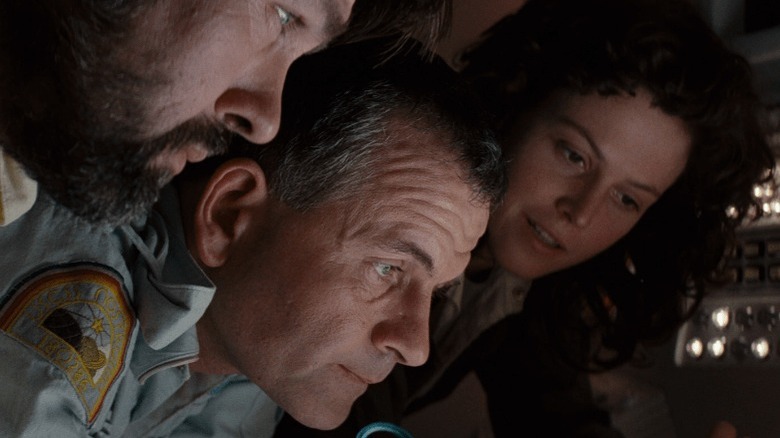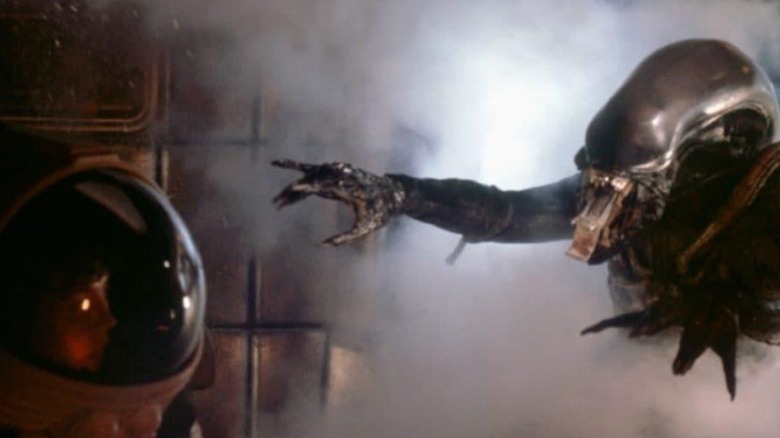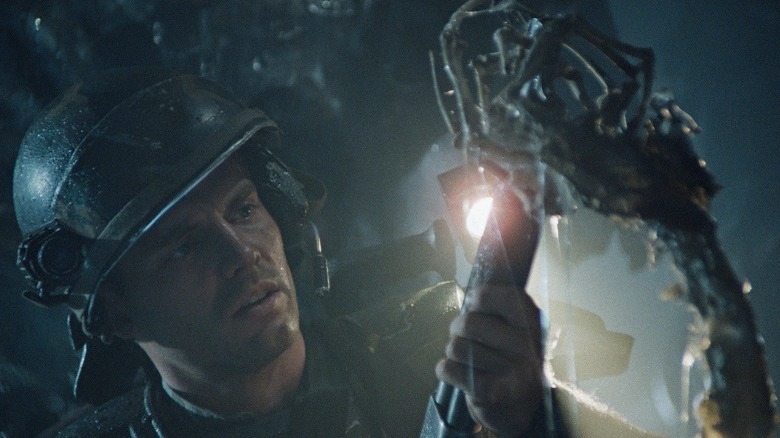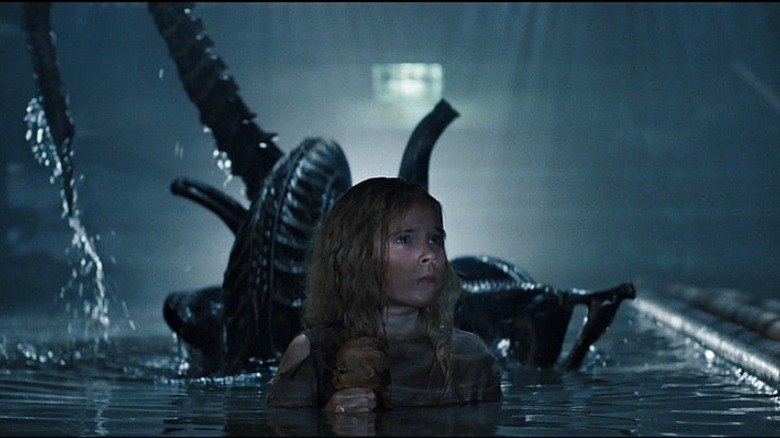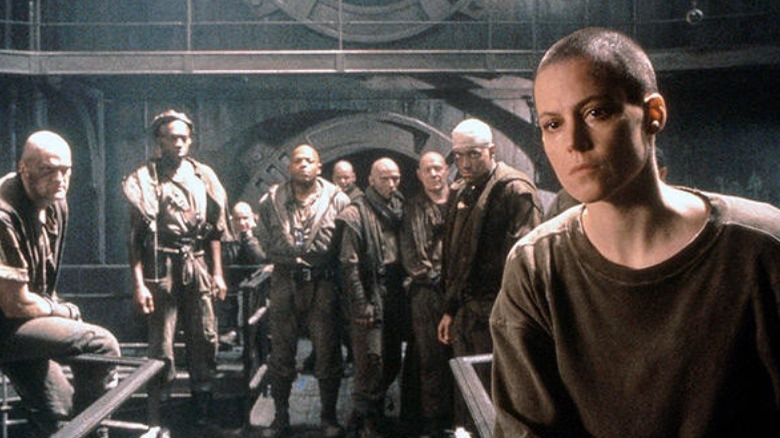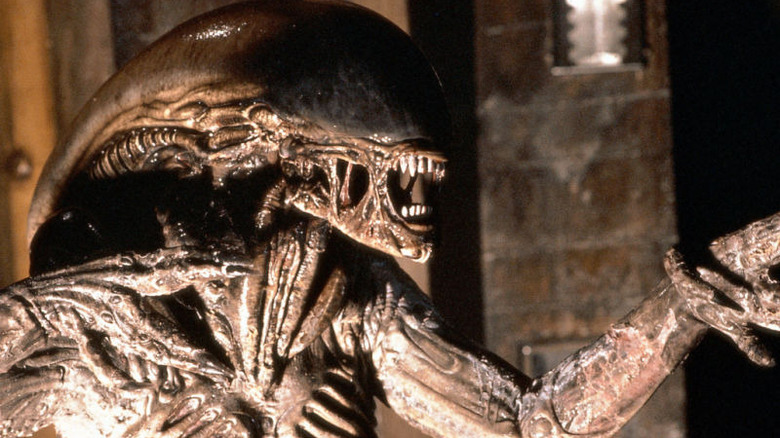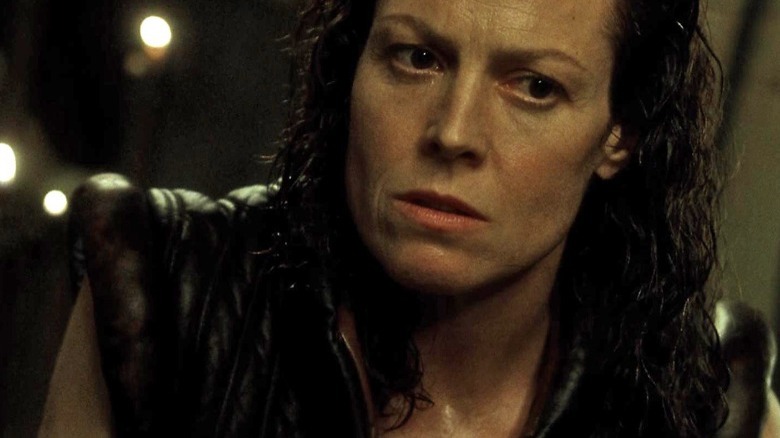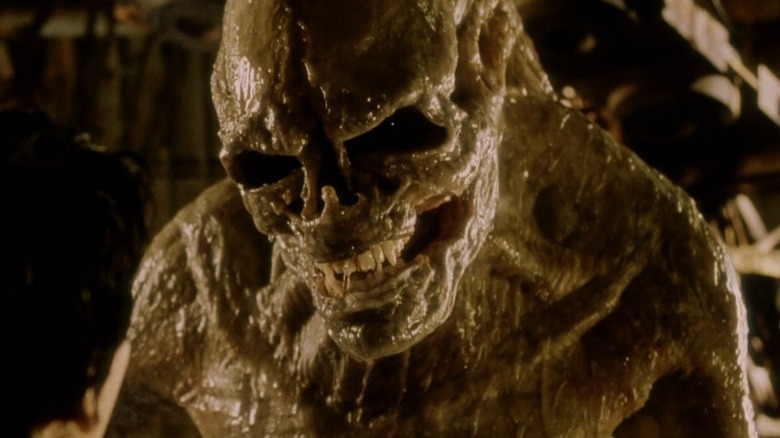The Ending Of Every Alien Movie Explained
In the late '70s, H. R. Giger designed one of the most horrifically terrifying movie monsters of all time in the fabled Xenomorph of the "Alien" franchise. With a skeletal build and an intense snarling jaw, would-be victims might as well kneel down and pray for a quick end as this death machine approaches. Glistening from the moisture that seems to fill the air in the hot spots these creatures are known for inhabiting, the alien — or Xenomorph, as it is designated in the films — is known for all sorts of fun surprises like its sharp and deadly tail, a secondary jaw that can launch from its mouth and punch a hole through flesh, and acidic blood capable of eating through the hulls of futuristic ships, setting crew members up for a devastating ride should they not resolve the problem quickly.
With this significant help from Giger, director Ridley Scott terrified audiences with grisly imagery and a pensive, moody atmosphere set aboard the Nostromo, a commercial space tug returning to Earth. "Alien" became the film to see in 1979 for fans of sci-fi and horror. Sigourney Weaver's Ellen Ripley led a top-notch cast including Tom Skerritt ("Contact," "Top Gun"), John Hurt ("The Elephant Man," "1984"), and Ian Holm ("The Lord of the Rings Trilogy"). The Ripley character would endure, both as an icon of the series and one of the most notable battle-hardened survivors in cinematic history.
Thanks to a series of sequels and prequels, the Xenomorph and its kind have experienced an ever-expanding legacy steeped in lore and world-building, in large part thanks to Scott and other considerable contributors including James Cameron and David Fincher. Let's take a look at each of the "Alien" films in chronological order, examining the epic conclusions of each, and how they set the stage for the next franchise adventure.
The invitation
"Prometheus" marked Ridley Scott's return to the franchise he began in 1979. But the prequel was a markedly different story than its predecessors, one with a pioneering spirit as humanity, led by Dr. Elizabeth Shaw (Noomi Rapace) and Dr. Charlie Holloway (Logan Marshall-Green) seeks answers in the year 2089 to the big question: Where do we come from?
The two archaeologists uncover time-spanning markings across multiple cultures, indicating that humans seemingly worshipped giant beings while also referencing the same star system. Funded by Peter Weyland of Weyland Corp., the two gather a crew and embark on a two-year journey in the name of discovery. Aboard the Prometheus, the crew slumber for much of the journey, only to be awakened by android David (Michael Fassbender) as the ship nears proximity to LV-223 — a distant moon targeted by the scientists for exploration.
Upon entry into the atmosphere of the moon, the crew quickly discovers strange structures protruding from the ground. They land and investigate, finding large statues of humanoid heads and weird objects that look like vases. The team also discovers a body belonging to one of the large humanoid beings. After retreating to the ship to study the specimen, two of the crew find themselves lost in the structure. A snake-like creature attacks and kills one of them, infecting the other. Meanwhile, David the android has taken one of the vases full of strange black goo for his own secret agenda. In a fated conversation with Dr. Holloway, David asks him what he'd do to receive answers. Holloway replied that he'd do anything. David then offers him a drink, one that he has poisoned with the black goo.
The engineers of humanity
Later, after doctors Holloway and Shaw enjoy some intimacy, he begins deteriorating. Holloway realizes he's been infected with an alien contagion and forces the crew's hand in killing him.
It's eventually revealed that Peter Weyland (Guy Pearce) isn't dead, as the crew had thought. Fearing death, he in fact used the crew to bring him to the alien race that created humanity, in hopes of discovering the key to immortality. The crew call the species "engineers" because they are believed to have created humanity. David located a living engineer in hyper-sleep and awakened the large humanoid being to interact with Peter Weyland. Ultimately, the engineer decapitates David and kills Peter Weyland.
Meanwhile, Dr. Shaw learns she is pregnant, then extracts an octopus-like alien creature from her abdomen using the technology aboard. Shaw quickly deduces that the black goo is a genetic-altering agent that the engineers were planning to use to wipe out human-kind, but they were seemingly killed by their own uncontrollable weapon. The living engineer hunts down Shaw, only for her to unleash the monster she birthed (which is now massive) on the engineer. She then takes David's head and, with his help, flies the engineer ship to their home world to hopefully answer a question: Why did they want to destroy humanity? In the final scene, the octopus-like creature is revealed to have been a proto-facehugger, who implants the engineer with a chest-bursting embryo similar to the Xenomorphs we're all familiar with.
The film presents itself as a cyclical allegory for man's quest to achieve the pretentious heights of godhood. The engineers perished in their endeavors creating weaponized life; humans like Weyland formed an ego that insisted immortality was their right. In so doing so, they too created a monster (David) that became their undoing.
Echoes of the past
Nearly 11 years after the events of "Prometheus," an android by the name of Walter (who resembles David of the Prometheus) patrols the halls of the Covenant — a ship carrying human embryos, 2,000 civilians, and an emergency crew. When a solar flare damages the ship, Walter awakens the emergency crew. Fatefully, the damage to the ship kills the emergency crew's captain. After the crew repair the ship, they receive a transmission that sounds oddly reminiscent of John Denver's "Country Roads." They track the signal to a habitable planet much closer than their targeted location of Origae-6, albeit still 6 years away.
Welcome to 2017's "Alien: Covenant," Scott's second prequel film to "Alien," this one set in the year 2104.
The new captain, Christopher Oram (Billy Crudup), makes the decision to investigate the transmission and possibly settle at this new planet that is only weeks away. The late-captain's wife and chief of terraforming, Katherine Daniels, feels the decision is flawed because this new planet hasn't been vetted.
Regardless of any dissenting opinions among the crew, the Covenant heads for the newly discovered planet. They discover the engineer ship with a holographic recording of Dr. Shaw singing "Country Roads." After trekking through the wilderness, two of the crew are infected by an airborne spore that gestates within them, killing them after a tiny alien creature dubbed the neomorph emerges from their bodies. The neomorphs attack the crew, killing some. Walter saves Katherine and sacrifices his hand to do so. Amid the chaos, a mystery figure emerges to lead the crew to safety. That figure is revealed to be David.
David's monster
While the crew seems trusting of their savior, they quickly learn there is more to him than meets the eye. Unlike Walter, David has learned how to embrace passion and emotion, whether simulated or real. This has enabled the android to develop a god-complex. It's revealed that he killed Dr. Shaw and dissected her to use her tissue for experimentation with the black goo he had recovered from the engineers. Furthering his madness, he wiped out the engineers from their home world, enacting the same plan they had laid out for humanity — he dropped the bio-agent onto the planet and watched it consume the inhabitants.
David engineered the genetic make-up of the species that spawns from the black goo to create the Xenomorph. Captain Christopher Oram learns first-hand what this species is capable of, as he succumbs to the first facehugger to emerge from an alien egg. The crew find the corpses of their comrades and head into "fight or flight" mode. Ultimately, flight wins out as they plan to leave the planet. What they don't know is that David dispatches of Walter and poses as him. He boards the Covenant — and so do two Xenomorphs.
After a harrowing third act where the Xenomorphs are destroyed, the remaining crew prepare to enter hyper-sleep as they finally travel to Origae-6. As Katherine enters her pod and "Walter" closes the door, she references a past remark she had made to him. Seeing that he doesn't know what she is referring to, she realizes in horror that he is actually David. But it's too late; David activates the chamber and she falls into hyper sleep. The final moments of the film see David placing alien embryos in cold storage. Apparently, the deadliest species in the galaxy has a bright future ahead of it.
Welcome to the Nostromo and LV-426
The first "Alien" film takes place 17 years after "Alien: Covenant." In the original, landmark flick, we are introduced to Ellen Ripley and the crew of the Nostromo. They are awakened from hyper-sleep on their journey back to Earth due to a distress signal; the captain makes the decision to investigate, much to the dismay of the crew. Upon arriving at LV-426, some of the crew disembark and find an alien ship; it belongs to the engineers, and so the crew find a dead engineer and several alien eggs. Curiosity kills, as a facehugger emerges and attaches itself to one of the crew.
This film establishes that an engineer ship was carrying several aliens aboard. While the engineers may have created the genetic-altering bio agent that spawned the original Neomorph, David was the final designer of the Xenomorph species. "Alien: Covenant" established that David enacted genocide on the engineers' home world and then headed off to Origae-6 with alien embryos in tow. Therefore, there seems to be a gap in the storyline, offering no explanation how another engineer ship landed on LV-426 with the Xenomorphs that David created. With an "Alien" TV series on the way and Ridley Scott indicating another film is "in process," it's possible this gap will be bridged in the future.
Alien aboard
After the crew fails in its attempts to safely remove the creature from their unfortunate colleague's face, the creature does the work for them ... after it had completed its business, of course. What the crew was unaware of was that the creature implanted an alien embryo down the gullet of the hapless explorer. When he awakens, seemingly no worse for the wear, his hidden passenger violently emerges from the chest cavity killing its host, shocking and horrifying the rest of the crew. The tiny alien, known as a chestburster in "Alien" lore, scurries off. As the crew hunt for the creature, they uncover sheets of skin indicating that the alien is rapidly growing in size. Before long, it's a full-grown adult that systematically kills each of the crew one by one.
Ash, the science officer revealed to be an android, is attempting to preserve the alien at the directive of Weyland Corp. for further study. Ellen Ripley uncovers the dirty secret that the company is perfectly fine with human casualties, as long as the specimen returns safely. Ellen deactivates Ash and then sets the ship to self-destruct while fleeing via an escape pod. The alien, however, hijacked her escape pod and after an intense struggle, she is able to blow the creature out of the space craft's airlock. Once her nerves are settled, she sets a course for Earth and jumps back into hyper-sleep.
At the center of "Alien" is an unsuspecting crew embroiled in an unseen conflict with a greedy corporation, presenting itself as a simple fight for survival against a valuable but deadly creature. Somehow, Weyland Corp. discovered the species and its location, a question that might be answered by a future film.
Return to LV-426
Picking up immediately where the prior film left off is James Cameron's 1986 film "Aliens." In it, the Weyland-Yutani Corporation retrieves Ripley's shuttle that has apparently been floating aimlessly for 57 years. She is debriefed by leadership within the company, who find hard to believe her stories of an alien creature that had acidic blood, two jaws, killer claws and a tail, and was born out of a gestating embryo within one of her crew members. Her claim is even further marred by the fact that LV-426 had become a terraforming colony called Hadley's Hope, in which no one had ever reported seeing a creature like the one she described.
A short while later, one of the Weyland-Yutani representatives, Carter Burke (Paul Reiser), informs Ellen that they lost contact with the colony. They are embarking on a mission to see what has happened and he asks Ellen to join the mission. She initially refuses, knowing the engineer ship was littered with eggs. When Burke confirms the mission is to destroy any alien species alive on the planet, Ellen agrees to join as a consultant. The unit investigating Hadley's Hope is a military unit, trained for infiltration and combat.
The infestation
"Aliens" does a stellar job at building anticipation. In fact, it's nearly an entire hour into the film before aliens are actually seen on screen. The tension and burgeoning dread of moving through the derelict halls of a processing station, that by all accounts should be populated, creates an atmosphere ripe for engagement and climactic struggles for survival. Ellen discovers a young girl by the name of Newt (Carrie Henn) who she intends to protect. After discovering the rest of the population trapped in cocoon-like goo, they realize the Xenomorphs preserved the colonists for breeding. Chestbursters begin to emerge from the tormented victims, and aliens attack Ellen and the Colonial Marines she is accompanying. The building is infested with countless aliens waiting to strike. The question then becomes: how are the eggs being created?
Most of the film is a failed attempt by the Marine unit at simple survival. The aliens pick the crew off one by one and eventually, Ellen Ripley, Newt, an android by the name of Bishop (Lance Henriksen), and Corporal Hicks (Michael Biehn) are the only survivors. Before Burke's death, Ellen learned that Burke ordered the colonists to investigate the engineer ship and was hoping to protect the species for weapons research and profit. He ultimately got his just desserts, being eviscerated by the species he aimed to secure.
The aliens then target Newt, taking her back to their hive to be used for breeding. Ellen heads into the heart of the alien nest to find the gigantic queen alien who produces the eggs. After retrieving Newt and escaping the queen, they board a ship to leave LV-426 behind for good. The queen, however, hijacks the ship and Ellen battles the monster in a loader ExoSuit, forcing it out of an airlock as means of termination. The remaining survivors then enter hyper sleep for a trip back to Earth.
A tragic end and new beginning on Fiorina 161
This brings us to the events of David Fincher's 1992 film, "Alien 3." It begins with a mysterious fire on the ship that Ellen and the survivors of "Aliens" were aboard in hyper sleep. The ship's computer launches the survivors in escape pods to the planet Fiorina 161.
Ellen is recovered, washed ashore on a beach by a man named Clemens (Charles Dance), who is a doctor at the prison facility just offshore. The facility operates as a maximum-security prison for male inmates. It's revealed that Newt, Corporal Hicks, and the android Bishop were all killed in the impact of the shuttle's crash landing. After Ellen gets to know the inmates and their erratic and violent tendencies, the warden ensures that a message has been sent to Weyland-Yutani Corporation to come collect her.
Nervous about what could have possibly caused the escape pods to be launched, Ellen has Clemens investigate by performing an autopsy on Newt's body, under the guise of fear that she was killed by a cholera contagion. Clemens, however, knows there is something far more concerning to Ellen than cholera; after noticing burn marks in the wreckage and similar burn marks from a possible acidic reaction in the facility following the death of an inmate, Ellen suspects that an alien has towed away on board her ship, and is now loose within the facility.
The deadly hijacker
Ellen finds and reactivates Bishop, who confirms her fears of a rogue alien aboard the ship. As is typical for an "Alien" film, the Xenomorph begins to pick off the prison inmates one by one. But the prison does not store weapons of any kind, managing prisoner occupations within the foundry based on the honor system. Therefore, they crew of convicts come up with a plan to lure the alien into a death trap.
During the struggle, Ellen begins to display symptoms of an illness. She has one of the inmates scan her body to find that she has been impregnated with a queen alien. Ripley realizes she must kill herself, but not before helping the prison crew stop the alien. Knowing it won't hurt her because she's pregnant, Ripley and the remaining crew corner the alien and dump molten on it, cooling it with the emergency sprinkler system and shattering the creature to pieces.
The Weyland-Yutani corporation then arrives. One of them is the spitting image of Bishop, and claims to be the android's designer. He attempts to convince her that they can safely remove the embryo from her body, but Ellen knows nothing good can come from the company extracting the queen for study. She jumps to her death in the molten lead, just as the queen emerges from her chest, killing them both. With her dying breath, Ellen brings an end to the entire Xenomorph species. Or, so it seems.
Resurrected
1997's Jean-Pierre Jeunet-directed "Alien: Resurrection" is the last film chronologically in the saga, and took a "Jurassic Park" approach, depicting the United Systems military's ill-advised attempt to clone the alien species some 200 years after the events of "Alien 3."
To do this, they utilize Ellen Ripley's DNA, creating a viable clone of her with the alien queen embryo still inside. Following several unsuccessful attempts, they finally create Ripley 8 (the eighth clone in a line of failures). While Ripley 8 maintains the real Ellen Ripley's genetic memories, she also holds characteristics and sensitivities to the alien hive, because of the alien DNA mixed into her genetic make-up. The same is true, however, of the alien queen. She now shares knowledge that Ellen Ripley once had.
A mercenary ship by the name of Betty soon arrives, complete with a rag tag crew of grunts and a rookie by the name of Annalee Call (Winona Ryder). They are delivering cargo to the USM, consisting of humans to serve as hosts for alien embryos. "Jurassic Park" taught viewers what would happen if we ever decided to use science to play god, so you can almost hear Ian Malcom's voice stammering "Life... uh, finds a way."
The sacrificial lambs do indeed produce aliens, who proceed to "find a way" as they use the recently obtained genetic knowledge of their acidic blood to break free of their containment by killing one of their own.
One big happy family
The aliens proceed to kill all the soldiers aboard that were unable to escape. After a frightening burst of bloodshed and mayhem, few survivors remain, including the mercenary group from the Betty. Ripley 8, who has super human strength and acidic blood thanks to her genetic connection to her alien family, helps the crew proceed through the massive military ship to the Betty. In the event of an emergency, the USM ship is automatically bound for Earth — a catastrophic action that could potentially unleash the alien swarms on our home planet. So, the team makes plans to escape via the Betty and destroy the USM ship before it reaches Earth.
Annalee Call is revealed to be an advanced android who sought to foil the military's plan to resurrect the aliens, and soon Ripley 8 is grabbed by a Xenomorph and taken back to their nest. She realizes that the alien queen also has a human-like reproductive system, and is now capable of birthing in a similar manner rather than the typical egg method of prior films; what emerges is a terrifying, human-alien abomination.
Ripley 8 nevertheless feels a connection to the creature as a result of their genetic relation. She escapes and boards the Betty with the rest of the crew. Unable to launch due to an open hatch, the crew attempt to close the hatch when the hybrid creature attacks. Ripley 8 stops the creature and uses its trust in her against it. As she hugs the creature, she utilizes the acid in her own blood to create a hole in the window, causing a vacuum that violently sucks the creature into space. The crew then descends upon Earth, optimistic for a future on the planet without the threat of a Xenomorph apocalypse.
